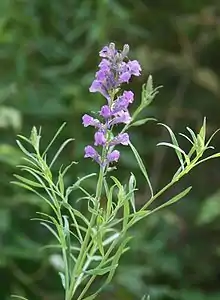Linaria purpurea
Linaria purpurea is a species of flowering plant in the plantain family known by the common name purple toadflax.[2][3] It is native to Italy,[4] but it can be found growing wild as an introduced species in parts of western North America, including California,[5] western Washington,[6] and British Columbia,[3] and it is cultivated as an ornamental plant.[7] It is a perennial herb growing 30 to 70 centimeters tall with linear leaves 2 to 5 centimeters in length. The inflorescence is a raceme of flowers occupying the top of the stem. The flower is between 1 and 2 centimeters long with five lobes arranged into two lips with a spur at the end. The flower is usually light to medium purple in color. This plant is poisonous to livestock, the larvae of some species of Lepidoptera use this plant as a food source.[8]
| Linaria purpurea | |
|---|---|
 | |
| Scientific classification | |
| Kingdom: | Plantae |
| Clade: | Tracheophytes |
| Clade: | Angiosperms |
| Clade: | Eudicots |
| Clade: | Asterids |
| Order: | Lamiales |
| Family: | Plantaginaceae |
| Genus: | Linaria |
| Species: | L. purpurea |
| Binomial name | |
| Linaria purpurea | |
| Synonyms[1] | |
| |
There is a pale pink cultivar of the species named 'Canon Went'.[9]
References
- The Plant List: A Working List of All Plant Species, retrieved 13 September 2016
- "BSBI List 2007". Botanical Society of Britain and Ireland. Archived from the original (xls) on 2015-01-25. Retrieved 2014-10-17.
- "Linaria purpurea". Natural Resources Conservation Service PLANTS Database. USDA. Retrieved 26 January 2016.
- "Linaria purpurea". Germplasm Resources Information Network (GRIN). Agricultural Research Service (ARS), United States Department of Agriculture (USDA). Retrieved 19 January 2018.
- Jepson Manual Treatment
- Burke Museum
- Kemper Garden Center
- "Purple Toadflax - Linaria purpurea, species information page". www.brickfieldspark.org. Retrieved 2016-06-30.
- https://www.rhs.org.uk/plants/details?plantid=1172